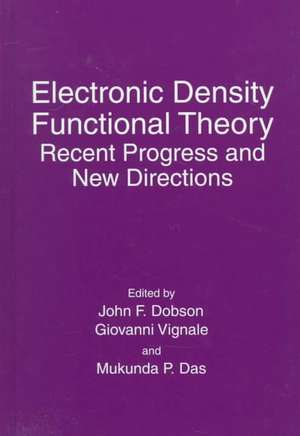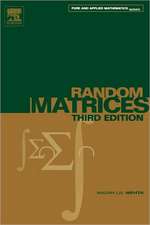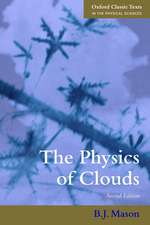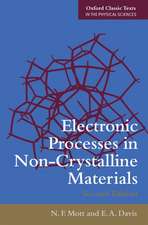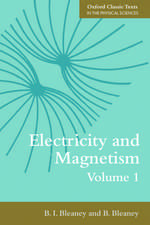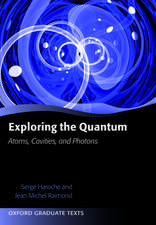Electronic Density Functional Theory: Recent Progress and New Directions
Editat de John F. Dobson, Giovanni Vignale, Mukunda P. Dasen Limba Engleză Hardback – 29 apr 1998
| Toate formatele și edițiile | Preț | Express |
|---|---|---|
| Paperback (1) | 954.45 lei 6-8 săpt. | |
| Springer Us – 28 mai 2013 | 954.45 lei 6-8 săpt. | |
| Hardback (1) | 957.94 lei 6-8 săpt. | |
| Springer Us – 29 apr 1998 | 957.94 lei 6-8 săpt. |
Preț: 957.94 lei
Preț vechi: 1168.21 lei
-18% Nou
Puncte Express: 1437
Preț estimativ în valută:
183.30€ • 191.38$ • 151.71£
183.30€ • 191.38$ • 151.71£
Carte tipărită la comandă
Livrare economică 04-18 aprilie
Preluare comenzi: 021 569.72.76
Specificații
ISBN-13: 9780306458347
ISBN-10: 0306458349
Pagini: 396
Ilustrații: X, 396 p.
Dimensiuni: 178 x 254 x 25 mm
Greutate: 0.8 kg
Ediția:1998
Editura: Springer Us
Colecția Springer
Locul publicării:New York, NY, United States
ISBN-10: 0306458349
Pagini: 396
Ilustrații: X, 396 p.
Dimensiuni: 178 x 254 x 25 mm
Greutate: 0.8 kg
Ediția:1998
Editura: Springer Us
Colecția Springer
Locul publicării:New York, NY, United States
Public țintă
ResearchDescriere
This book is an outcome of the International Workshop on Electronic Density Functional Theory, held at Griffith University in Brisbane, Australia, in July 1996. Density functional theory, standing as it does at the boundary between the disciplines of physics, chemistry, and materials science, is a great mixer. Invited experts from North America, Europe, and Australia mingled with students from several disciplines, rapidly taking up the informal style for which Australia is famous. A list of participants is given at the end of the book. Density functional theory (DFT) is a subtle approach to the very difficult problem of predicting the behavior of many interacting particles. A major application is the study of many-electron systems. This was the workshop theme, embracing inter alia computational chemistry and condensed matter physics. DFT circumvents the more conceptually straightforward (but more computationally intensive) approach in which one solves the many-body Schrodinger equation. It relies instead on rather delicate considerations involving the electron number density. For many years the pioneering work of Kohn and Sham (the Local Density Ap proximation of 1965 and immediate extensions) represented the state of the art in DFT. This approach was widely used for its appealing simplicity and computability, but gave rather modest accuracy. In the last few years there has been a renaissance of interest, quite largely due to the remarkable success of the new generation of gradient functionals whose initiators include invitees to the workshop (Perdew, Parr, Yang).
Cuprins
Introductory Material: Brief Introduction to Density Functional Theory; J.F. Dobson, M.P. Das. Digging Into the Exchange-Correlation Energy: The Exchange-Correlation Hole;K. Burke. Invited Chapters on Groundstate Energy Functionals: Mixing Exact Exchange with GGA: When to Say When; K. Burke, et al. Adiabatic Coupling in the Helium and the Beryllium Series;A. Savin, et al. Invited Chapters on Excited States, Time-Dependent DFT and the van der Waals Interaction: Are Unoccupied Kohn-Sham Eigenvalues Related to Excitation Energies? C.J. Umrigar, et al. Time-Dependent Optimized Effective Potential in the Linear Response Regime; M. Petersilka, et al. Invited Chapters on Special Systems: Edge Electronic Structure: The Airy Gas; W. Kohn. Density Functionals for Energies and Eigenvalues: Local Mass Approximation; G.E. Engel, W.E. Pickett. Abstracts of Poster Presentations: Ab Initio Calculations of Magnetic Interactions in Magnetic Metal Alloys via the LSDF Approach; M.F. Ling. UNICHEM and Electron Momentum Spectroscopy Investigations into the Valence Electronic Structure of Trans 1,3 Butadiene; M.T. Michalewicz, et al. 20 Additional Chapters. Index.
